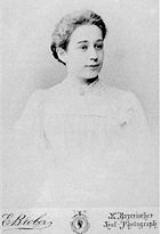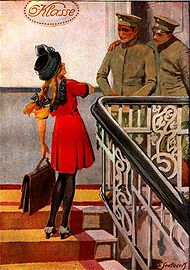
Else Ury
Encyclopedia
Else Ury was a German writer and children's book author. Her best-known character is the blonde doctor's daughter Annemarie Braun, whose life from childhood to old age is told in the ten volumes of the highly successful Nesthäkchen series. The books, the six-part TV series Nesthäkchen (1983), based on the first three volumes, as well as the new DVD edition (2005) caught the attention of millions of readers and viewers. During Ury's lifetime Nesthäkchen und der Weltkrieg (Nesthäkchen and the World War), the fourth volume, was the most popular. Else Ury was a member of the German Bürgertum (middle class). She was pulled between patriotic German citizenship and Jewish cultural heritage. This situation is reflected in her writings, although the Nesthäkchen books make no references to Judaism.
Sustained by these concepts of Bildung (education), Else Ury’s siblings started successful middle class careers: Ludwig (1870–1963) became a lawyer, Hans (1873–1937) a medical doctor and Käthe (1881–1944), before getting married and starting a family, planned to train as a teacher. Else, however, despite attending the Lyzeum Königliche Luisenschule, chose not to pursue a profession. She started writing, under a pen name, for the Vossische Zeitung. In 1905 her first book, Was das Sonntagskind Erlauscht (What the Lucky Child Heard), was published by the Globus Verlag. This collection of thirty-eight moral tales promotes pedagogical ideals such as loyalty, honesty and faithfulness. Ury’s subsequent book Goldblondchen (1908) earned her an honorary remark by the influential Jugendschriftenwarte and a further five publications built on this success, until eventually the Nesthäkchen series was published between 1918 and 1925 and made her a famous author.
With over thirty-nine books Else Ury was not only one of the most productive female writers of her time, she was also one of the most successful. The combination of an educated mind, humour and compassionate femininity made her books into bestsellers and she was highly celebrated. On her fiftieth birthday, on 1 November 1927, for instance, her publisher, Meidigers Jugendschriftenverlag, honoured her with a large reception at the famous Hotel Adlon
.
As a Jew during the Holocaust, Ury was barred from publishing, stripped of her possessions, deported to Auschwitz and gassed the day after she arrived. A cenotaph in Berlin's Weissensee Jewish Cemetery (Jüdischer Friedhof Weißensee) memorializes her.
 Else Ury describes in Nesthäkchen and the World War the experiences of Annemarie Braun, who is eleven years old when the story begins and thirteen when it ends. Annemarie's father serves as an army surgeon in France. Annemarie’s mother is in England with relatives and is not able to return to Germany due to the outbreak of war. Annemarie and her two older brothers, Hans and Klaus, are cared for by a grandmother. Much of Ury’s narrative deals with Annemarie’s experiences with a new classmate, the German-Polish Vera, who does not speak German at the beginning of the story. The popular, headstrong Annmarie coldly excludes Vera from her circle of friends as a foreigner and an alleged spy, making the beautiful, friendly Vera into a class pariah. The resolution of this painful situation builds to a shocking, ringing climax, which has enthralled readers since the book’s publication. Moreover, the ominously unfolding war in the background gives Nesthäkchen and the World War poignancy and depth, a timeless commentary on the brutal nature of war.
Else Ury describes in Nesthäkchen and the World War the experiences of Annemarie Braun, who is eleven years old when the story begins and thirteen when it ends. Annemarie's father serves as an army surgeon in France. Annemarie’s mother is in England with relatives and is not able to return to Germany due to the outbreak of war. Annemarie and her two older brothers, Hans and Klaus, are cared for by a grandmother. Much of Ury’s narrative deals with Annemarie’s experiences with a new classmate, the German-Polish Vera, who does not speak German at the beginning of the story. The popular, headstrong Annmarie coldly excludes Vera from her circle of friends as a foreigner and an alleged spy, making the beautiful, friendly Vera into a class pariah. The resolution of this painful situation builds to a shocking, ringing climax, which has enthralled readers since the book’s publication. Moreover, the ominously unfolding war in the background gives Nesthäkchen and the World War poignancy and depth, a timeless commentary on the brutal nature of war.
After 1945 the new publisher removed Nesthäkchen and the World War from the Nesthäkachen series, because the book was on the censorship list of the Allied control boards. Ury was, like most German Jews, fiercely patriotic, and her descriptions of the events in and around the First World War were classified as glorifying war. Since 1945 the Nesthäkchen series has consisted of only 9 volumes. Steven Lehrer
translated Nesthäkchen and the World War into English in 2006. Ury also wrote other books and stories, primarily for girls and young women. German women still buy and read Ury's books, almost all of which are in print.
Frankfurt/Main: dipa 1983. (= Jugend und Medien. 4.) ISBN 3763801170. S. 263-336.
Life
Else Ury was born in Berlin on 1 November 1877, into a family of Jewish merchants. Her happy childhood and her life with the extended families Ury and Heymann provided the loving environment and inspiration to write her books. The prosperous bourgeois household with cook, governess, housemaid, doorman and impressive furniture which is described by Else Ury in her Nesthäkchen series or in Studierte Mädel (1906) is a direct reflection of her life in Berlin, particularly after moving to the Kantstraße in Charlottenburg, and later on to Kaiserdamm. While her father Emil (1835–1920) became a successful merchant, her mother Franziska Ury (1847-1840) represented the German Bildungsbürgertum (educated middle class). Franziska passed her interest in classic and modern literature, the arts and music on to her children.Sustained by these concepts of Bildung (education), Else Ury’s siblings started successful middle class careers: Ludwig (1870–1963) became a lawyer, Hans (1873–1937) a medical doctor and Käthe (1881–1944), before getting married and starting a family, planned to train as a teacher. Else, however, despite attending the Lyzeum Königliche Luisenschule, chose not to pursue a profession. She started writing, under a pen name, for the Vossische Zeitung. In 1905 her first book, Was das Sonntagskind Erlauscht (What the Lucky Child Heard), was published by the Globus Verlag. This collection of thirty-eight moral tales promotes pedagogical ideals such as loyalty, honesty and faithfulness. Ury’s subsequent book Goldblondchen (1908) earned her an honorary remark by the influential Jugendschriftenwarte and a further five publications built on this success, until eventually the Nesthäkchen series was published between 1918 and 1925 and made her a famous author.
With over thirty-nine books Else Ury was not only one of the most productive female writers of her time, she was also one of the most successful. The combination of an educated mind, humour and compassionate femininity made her books into bestsellers and she was highly celebrated. On her fiftieth birthday, on 1 November 1927, for instance, her publisher, Meidigers Jugendschriftenverlag, honoured her with a large reception at the famous Hotel Adlon
Hotel Adlon
Hotel Adlon is a hotel on Unter den Linden, the main boulevard in the Berlin city centre, directly opposite the Brandenburg Gate.-First Hotel Adlon 1907-1945:...
.
As a Jew during the Holocaust, Ury was barred from publishing, stripped of her possessions, deported to Auschwitz and gassed the day after she arrived. A cenotaph in Berlin's Weissensee Jewish Cemetery (Jüdischer Friedhof Weißensee) memorializes her.
Nesthäkchen and the World War

After 1945 the new publisher removed Nesthäkchen and the World War from the Nesthäkachen series, because the book was on the censorship list of the Allied control boards. Ury was, like most German Jews, fiercely patriotic, and her descriptions of the events in and around the First World War were classified as glorifying war. Since 1945 the Nesthäkchen series has consisted of only 9 volumes. Steven Lehrer
Steven Lehrer
Steven Lehrer is a physician and writer, known for medical research and for his English translation of Else Ury.-Early years and education:Lehrer was born in Los Angeles...
translated Nesthäkchen and the World War into English in 2006. Ury also wrote other books and stories, primarily for girls and young women. German women still buy and read Ury's books, almost all of which are in print.
Nesthäkchen series
- 1913/18 Nesthäkchen und ihre Puppen
- 1915/18 Nesthäkchens erstes Schuljahr
- 1915/21 Nesthäkchen im Kinderheim
- 1917/21 Nesthäkchen und der Weltkrieg (Translation: Nesthäkchen and the World War)
- 1919 Nesthäkchens Backfischzeit
- 1921 Nesthäkchen fliegt aus dem Nest
- 1923 Nesthäkchen und ihre Küken
- 1924 Nesthäkchens Jüngste
- 1924 Nesthäkchen und ihre Enkel
- 1925 Nesthäkchen im weißen Haar
Professors Zwillinge series
- 1923 Professors Zwillinge Bubi und Mädi
- 1925/26 Professors Zwillinge in der Waldschule
- 1927 Professors Zwillinge in Italien
- 1928 Professors Zwillinge im Sternenhaus
- 1929 Professors Zwillinge – Von der Schulbank ins Leben
Novels
- 1906 Studierte Mädel
- 1908 Goldblondchen
- 1910 Baumeisters Rangen
- 1911 Vierzehn Jahr' und sieben Wochen
- 1913 Kommerzienrats Olly
- 1914 Das graue Haus
- 1916 Dornröschen
- 1917 Das Ratstöchterlein von Rothenburg
- 1918 Flüchtlingskinder
- 1919 Lieb Heimatland
- 1920 Lilli Liliput
- 1921 Hänschen Tunichgut
- 1925 Lillis Weg
- 1929 Studierte Mädel von heute
- 1930 Das Rosenhäusel
- 1930 Wie einst im Mai
- 1933 Kläuschen und Mäuschen
- 1933 Jugend voraus
Short Story Collections
- 1905 Was das Sonntagskind erlauscht
- 1910 Babys erstes Geschichtenbuch
- 1914 Huschelchen
- 1917 Lotte Naseweis
- 1923 Jungmädelgeschichten
- 1931 Wir Mädels aus Nord und Süd
- 1932 Für meine Nesthäkchenkinder
Further reading
- Marianne Brentzel: Nesthäkchen kommt ins KZ – Eine Annäherung an Else Ury 1877–1943. eFeF Verlag Zürich/Dortmund 1993, ISBN 3931782360
- Marianne Brentzel: Mir kann doch nichts geschehen: Das Leben der Nesthäkchen-Autorin Else Ury. Berlin: Edition Ebersbach, 2007. ISBN 978-3-938740-54-5
- Angelika Grunenberg: Die Welt war so heil – Die Familie der Else Ury. Chronik eines jüdischen Schicksals. Verlag List Berlin 2006, ISBN 9783548606835
- Lüke, Martina. “Else Ury – A Representative of the German-Jewish ‘Bürgertum’.” “Not an Essence but a Positioning”: German-Jewish Women Writers 1900-38. Eds. Godela Weiss-Sussex and Andrea Hammel. Martin Meidenbauer Verlag: München, 2009 and Institute of Germanic & Romance Studies; School of Advanced Study, University of London, 2009 (Publication of the Institute of Germanic Studies, 93). 77-93. ISBN 978-3-89975-161-1
- Aiga Klotz: Kinder- und Jugendliteratur in Deutschland: 1840–1950 (Gesamtverzeichnis der Veröffentlichungen in deutscher Sprache / Aiga Klotz. – Stuttgart: Metzler; (dt.) (Repertorien zur deutschen Literaturgeschichte)
- Susanne Zahn: Töchterleben. Studien zur Sozialgeschichte der Mädchenliteratur.
Frankfurt/Main: dipa 1983. (= Jugend und Medien. 4.) ISBN 3763801170. S. 263-336.
- Gesamtverzeichnis des deutschsprachigen Schrifttums (Geils, Peter)
External links
- Kirkus review of Nesthäkchen and the World War
- Else Ury at findagrave.com
- Alte Kinderbücher von Else Ury und Magda Trott at www.altekinderbuecher.de
- Bines Magda Trott, Else Ury und Kränzchen-Bibliothek Seite at omnibus.uni-freiburg.de
- Else Ury: Else Ury Bücher at www.kibuphoma.de
- at www.beepworld.de
- Else-ury at www.ghwk.de
- Nesthäkchen and the World War on Google Books

